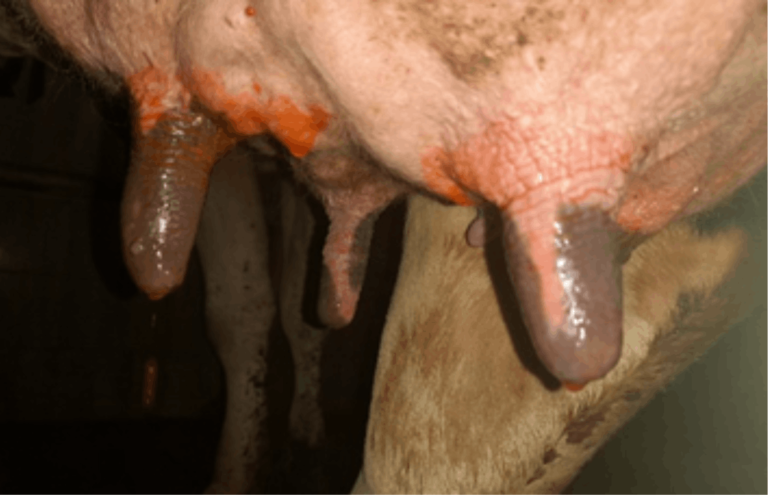DRYING-OFF DAIRY COWS

MESSA IN ASCIUTTA DELLA VACCA DA LATTE:
Recent international research has shown that even cows with a somatic cell count below 200,000 at the time of drying off may have quarters infected with mammary pathogens. Specifically, a study conducted in collaboration with the University of Montreal in Québec and published in the American Dairy Science Association analysed approximately 800 cows with cell counts below 200,000. Bacteriological examinations of individual quarters revealed that around 20% showed bacterial growth.
This scientific publication confirms our practical observations from over forty years of experience in the bovine veterinary sector. The use of only an internal teat sealant in cows with somatic cell counts below 200,000 entails certain risks.
It is essential to first assess the actual health status of the udder by performing at least a California Mastitis Test (CMT) at the time of drying off. Additionally, a bacteriological examination with an antibiogram should be conducted in so-called ‘problem herds’, particularly in cases where infectious pathogens are present.
HYGIENIC ROUTINE FOR PRODUCT APPLICATION DURING DRYING OFF:
- Thoroughly clean the teats, also using a pre-dipping solution.
- Perform the California Mastitis Test (CMT).
- Fully milk out all quarters.
- Carefully disinfect the teat tips and sphincters using cotton and alcohol.
- Apply the products according to the prescribed protocol.
- Insert Papilla Seal using only the tip of the applicator, while keeping the base of the teat compressed to prevent the product from entering the teat cistern.
- Apply a film-forming post-dipping solution.
OUR DRY-OFF PROPOSAL
FOR FARMS ENROLLED IN ARA (Standard Procedure)
Based on periodic functional checks, monitor the individual somatic cell count throughout lactation (also verifying the previous year’s data) and apply the appropriate protocol. If opting for treatment with SALVALAT ASCIUTTA, perform the CMT a few days in advance, treat the positive quarters, milk out the treated quarters for a few days, and then complete the treatment either with antibiotics or directly with PAPILLA SEAL.
PROTOCOLS
COWS WITH SOMATIC CELL COUNT < 200,000
- Perform CMT at drying off.
- For positive quarters, treat with SALVALAT ASCIUTTA as an alternative to antibiotic therapy.
- Use PAPILLA SEAL as a teat sealant.
COWS WITH SOMATIC CELL COUNT BETWEEN 200,000 AND 1,000,000
- Perform CMT at drying off.
- Treat positive quarters with either a lactation antibiotic (after an antibiogram) or SALVALAT ASCIUTTA.
- Use a dry-off antibiotic for positive quarters (after an antibiogram).
- Apply PAPILLA SEAL as a teat sealant.
COWS WITH SOMATIC CELL COUNT > 1,000,000
- Perform CMT at drying off.
- Treat positive quarters using SALVALAT ASCIUTTA aerosol, followed by antibiotic therapy (after an antibiogram).
- Use a dry-off antibiotic for positive quarters (after an antibiogram).
- Apply PAPILLA SEAL as a teat sealant.
RECOVERY DURING DRY-OFF FOR CHRONIC COWS (Low Recovery Rate)
- Perform CMT at drying off.
- Treat positive quarters using SALVALAT ASCIUTTA aerosol, followed by local antibiotic therapy (after an antibiogram).
- Administer systemic antibiotic therapy via intramuscular injection.
- Use a dry-off antibiotic for positive quarters (after an antibiogram).
- Apply PAPILLA SEAL as a teat sealant.
FOR FARMS NOT ENROLLED IN ARA
In the absence of chronic case identification, the risk of treatment failure increases significantly, and selective drying-off should only be applied if the farmer still decides to proceed.
- Perform CMT at drying off on all animals. Positive quarters may be treated with local antibiotics (after an antibiogram) or with SALVALAT ASCIUTTA aerosol, followed by PAPILLA SEAL as a teat sealant.
- For cows that have shown clinical mastitis during lactation, intramuscular antibiotic therapy should also be administered.
FOR FARMS WITH INFECTIOUS MASTITIS ISSUES
The management and resolution of these problems are at the discretion of the farm veterinarian.
We remain available, upon request, to intervene with detailed action plans tailored to each farm.